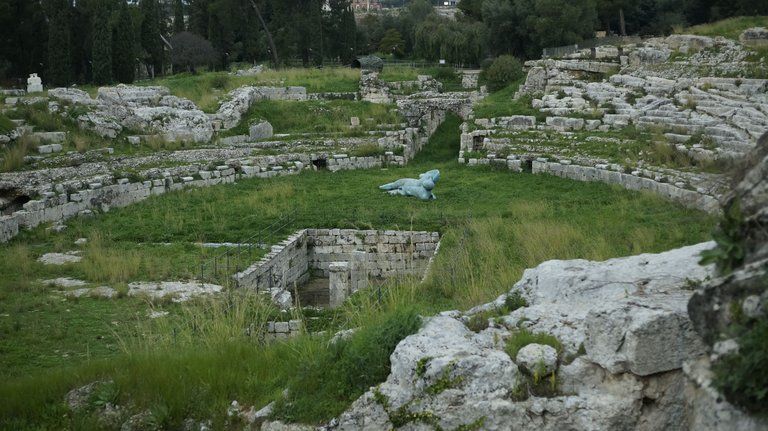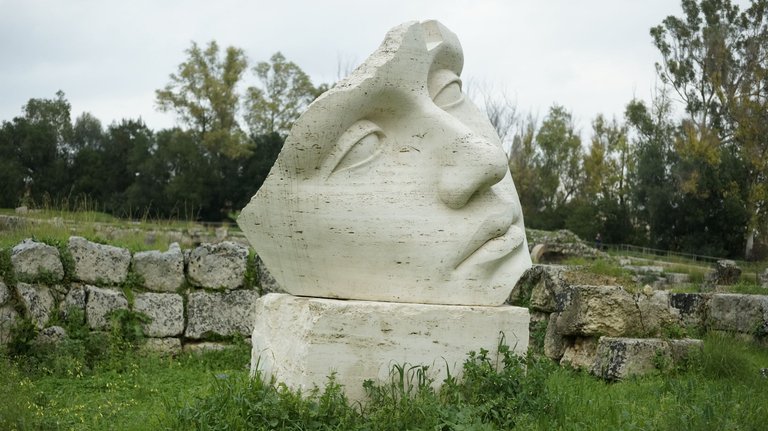
W 2025 roku będzie miało miejsce niezwykle ważne dla polskiej sztuki wydarzenie. W Pietrasanta, mieście w którym znajdowała się pracownia Igora Mitoraja, zostanie otwarta jego muzeum. W ubiegłym roku minęła dziesiąta rocznica śmierci artysty i nic nie wskazuje na to, żeby jego twórczość miała zostać zapomniana. Przeciwnie, zyskuje coraz to nowych wielbicieli i jego wystawy odbywają się w coraz bardziej prestiżowych miejscach. Mitoraj był pochodzenia polsko-francuskiego, urodził się we Francji, lecz wychował i odbył swoją edukację artystyczną w Polsce. Jego mistrzem w krakowskiej Akademii był Tadeusz Kantor, który namówił go do wyjazdu do Paryża. Po wyjeździe Mitoraj nie wrócił już do Polski, i może fakt jego nieobecności w polskim życiu artystycznym sprawił, że bardziej od niego cenieni w kraju są na przykład Magdalena Abakanowicz, Gustaw Zemła czy Władysław Hasior. Historycy sztuki nowoczesnej nie uważają go zwykle za twórcę najwyższej rangi. Jednak nikt z innych polskich rzeźbiarzyu nie odniósł międzynarodowego sukcesu porównywalnego z sukcesem Mitoraja. Z pewnością jego sztuce pomogło powołanie firmy Atelier Mitoraj S.r.I., która po śmierci artysty zajęła się promocją jego spuścizny i, co ciekawsze, realizacją pomysłów, których artysta nie zdołał zrealizować za życia. Jednym z najbardziej spektakularnych było umieszczenie dzieł Mitoraja na terenie Pompejów. Dzieł żadnego innego współczesnego artysty nie spotkał taki zaszczyt. Co więcej, okazało się że są one idealnym dopełnieniem pompejańskich ruin. Ich obecność tam jest świadectwem żywego dialogu pomiędzy dziełami odległymi od siebie o tysiące lat, co więcej dopiero umieszczenie rzeźb Mitoraja w antycznym kontekście odsłania w pełni ich znaczenia. Łączenie dzieł z różnych epok nie jest niczym nowym we współczesnej praktyce kuratorskiej. Jednak na ogół taki zabieg się nie udaje i pozostaje jedynie świadectwem wygórowanych aspiracji artystów i kuratorów, którzy chcieliby dla współczesnych prac uszczknąć nieco estymy, jaką cieszą się prace dawnych mistrzów. W przypadku Mitoraja taka sytuacja nie istnieje. W antycznym świecie jego rzeźby są „u siebie”. Odkrywają archetypiczne sensy, które przekraczają granice stuleci.
In 2025, an important event for Polish art will take place. His museum will open in Pietrasanta, the city where Igor Mitoraj's studio was located. Last year marked the tenth anniversary of the artist's death, and there is no indication that his work is about to be forgotten. On the contrary, he is gaining more and more admirers and his exhibitions are held in more and more prestigious places. Mitoraj was of Polish-French descent, born in France, but raised and received his artistic education in Poland. His master at the Krakow Academy was Tadeusz Kantor, who persuaded him to go to Paris. After his departure, Mitoraj did not return to Poland, and perhaps the fact of his absence from Polish artistic life made him more highly regarded in the country than, for example, Magdalena Abakanowicz, Gustaw Zemla or Władysław Hasior. Historians of modern art do not usually consider him an artist of the highest rank. However, none of the other Polish sculptors has achieved international success comparable to that of Mitoraj. Certainly his art was helped by the establishment of the Atelier Mitoraj S.r.I. company, which, after the artist's death, took on the promotion of his legacy and, more interestingly, the realization of ideas that the artist failed to realize during his lifetime. One of the most spectacular was the placement of Mitoraj's works on the Pompeii site. The works of no other contemporary artist have received such an honor. What's more, they turned out to be the perfect complement to the Pompeian ruins. Their presence there is a testament to the lively dialogue between works thousands of years apart; moreover, only by placing Mitoraj's sculptures in an ancient context do they fully reveal their meanings. Combining works from different eras is nothing new in contemporary curatorial practice. However, in general, such an approach fails and remains only a testimony to the exaggerated aspirations of artists and curators, who would like to take away for contemporary works a little of the esteem enjoyed by the works of the old masters. In the case of Mitoraj, such a situation does not exist. His sculptures are “at home” in the ancient world. They reveal archetypal senses that transcend centuries.
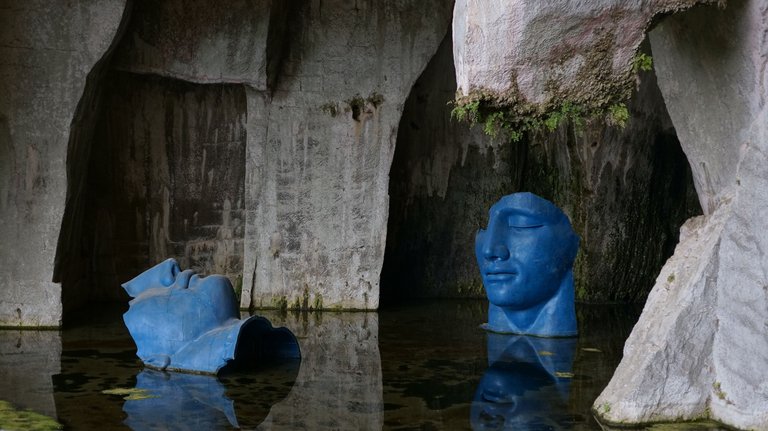
Chyba najlepszą możliwością poznania i zrozumienia sztuki Mitoraja jest trwająca na Sycylii do 31. października 2025 plenerowa wystawa jego prac „Igor Mitoraj. Lo Sguardo. Humanitas. Physis”. Nie wszyscy zobaczą tę wystawę w całości, bowiem została ona zaplanowana w trzech miejscach. Główna część wystawy znalazła się na terenie ruin greckich świątyń i amfiteatru oraz używanego przez Greków kamieniołomu (obecnie to teren „Parco Archeologico e paesaggistico di Siracusa”), druga część to ekspozycja rzeźby Wielka Ikaria na dawnym Placu Broni przylegającym do zamku Maniace na Ortigii, natomiast trzecia to pokaz Spękanego Tezeusza na stoku Etny.
Perhaps the best opportunity to learn about and understand Mitoraj's art is the ongoing open-air exhibition of his works in Sicily until October 31, 2025, "Igor Mitoraj. Lo Sguardo. Humanitas. Physis." Not everyone will see the exhibition in its entirety, as it has been scheduled in three locations. The main part of the exhibition was located on the site of the ruins of Greek temples and an amphitheater, as well as a quarry used by the Greeks (now the site of the “Parco Archeologico e paesaggistico di Siracusa”), the second part is the display of the Great Icaria sculpture in the former Arms Square adjacent to the Maniace Castle on Ortigia, while the third part is the display of the Cracked Theseus on the slope of Mount Etna.
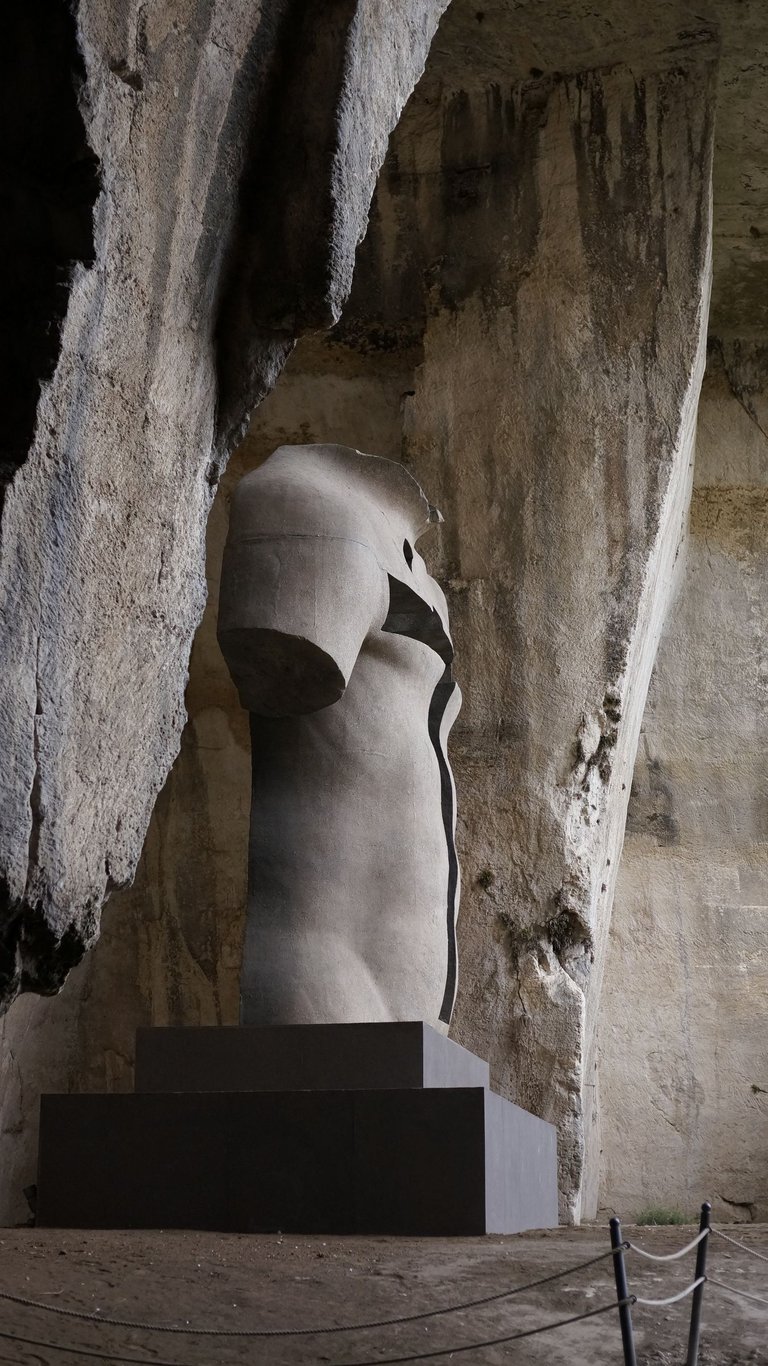
Mimo nieobecności artysty w Polsce jego dzieła są dobrze znane. Arysta nieustannie powracał do tych samych motywów zakorzenionych w antyku. Zobaczywszy kilka jego rzeźb ma się wrażenie, że zna się je wszystkie. To oczywiście złudzenie bo, jak ta wystawa pokazała, każdą z nich można na inny sposób odczytywać. Wystawie towarzyszy katalog dostępny dla zwiedzających po zeskanowaniu kodu QR i chyba nie został on wydany, w każdym razie na wystawie wersja papierowa nie była dostępna. Teksty towarzyszące dziełom nie są podpisane, ale można się domyślać, że ich autorem jest kurator wystawy Luca Pizzi, dyrektor artystyczny Atelier Mitoraj. Są one chyba najlepszym wprowadzeniem do sztuki Mitoraja, jakie miałem okazję czytać. Autor w dość zwięzłych hasłach ujmuje to co dla rozumienia sensu rzeźb artysty jest najważniejsze. Z jednej strony ich egzystencjalną ponadczasowość a z drugiej ich materialną formę doskonale współgrającą z miejscami pamięci, takimi jak Pompeje czy Syrakuzy. Mitoraj tworzy rzeźby nieraz łudząco podobne do antycznych, lecz zawsze noszące w sobie jakiś ślad zniszczenia. Nikt chyba nie porównywał Mitoraja z Boznańską, ale jej obrazy też były porównywane do dawnych, wyblakłych gobelinów, a więc dzieł także niosących ślady zniszczenia i upływu czasu. Ta metafora przypominająca nam nieustannie o naszym oddaleniu od kultury dawnej Grecji i Rzymu i jej niepełnej obecności we współczesności (mimo tego, że szczycimy się byciem spadkobiercami kultury śródziemnomorskiej) jest obecna we wszystkich pracach Mitoraja. A przy tym, mimo całej pamięci zniszczenia, zniewolenia i utraty widzenia celu (Mitoraj jest antymodernistą) jakich ludzkość doświadcza i jakie są wyrażane w rzeźbach Mitoraja, jest w nich piękno i harmonia.
Despite the artist's absence in Poland, his works are well known. Arysta constantly returned to the same motifs rooted in antiquity. Having seen several of his sculptures, one has the impression that one knows them all. This is, of course, an illusion because, as this exhibition has shown, each of them can be read in a different way. The exhibition is accompanied by a catalog available to visitors after scanning the QR code, and I guess it was not published; in any case, a paper version was not available at the exhibition. The texts accompanying the works are unsigned, but one can guess that their author is the exhibition curator Luca Pizzi, artistic director of Atelier Mitoraj. They are perhaps the best introduction to Mitoraj's art that I have had the opportunity to read. The author captures in rather succinct terms what is most important for understanding the meaning of the artist's sculptures. On the one hand, their existential timelessness and, on the other hand, their material form that perfectly harmonizes with memorial sites such as Pompeii or Syracuse. Mitoraj creates sculptures sometimes deceptively similar to ancient ones, but always bearing some trace of destruction. No one seems to have compared Mitoraj with Boznanska, but her paintings have also been compared to ancient, faded tapestries, works that also bear traces of destruction and the passage of time. This metaphor that constantly reminds us of our remoteness from the culture of ancient Greece and Rome and its incomplete presence in modern times (despite the fact that we pride ourselves on being heirs to Mediterranean culture) is present in all of Mitoraj's works. And at the same time, despite all the memory of destruction, enslavement and loss of vision of purpose (Mitoraj is an anti-modernist) that humanity is experiencing and that are expressed in Mitoraj's sculptures, there is beauty and harmony in them.
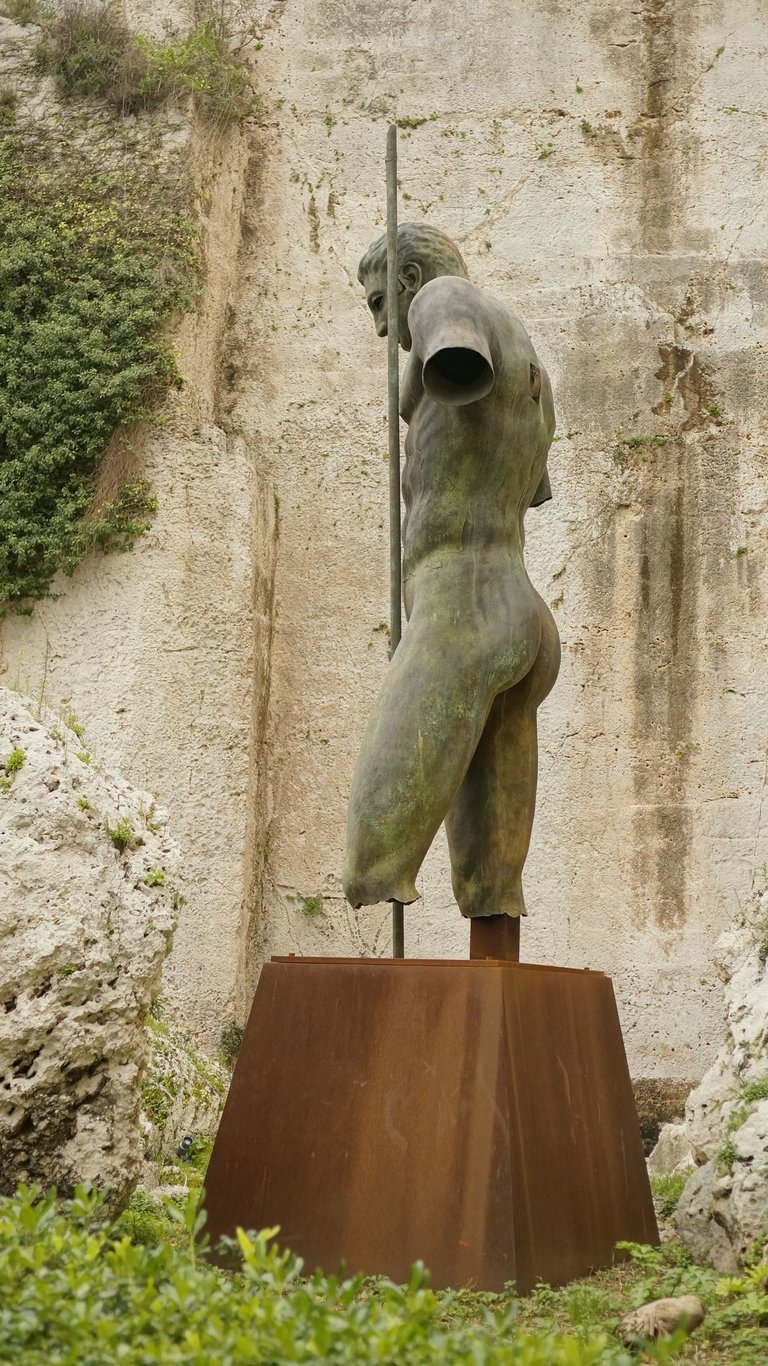
Luca Pizzi wydobył znaczenia poszczególnych tematów sztuki Mitoraja i stworzył z jego prac fascynującą opowieść. Nie przypominam sobie wystawy, która w tek doskonały sposób łączyłaby „genius loci” miejsca, w którym się odbywa i istotne znaczenie dzieł, które prezentuje. Jego komentarze towarzyszące dziełom, są najlepszym wprowadzeniem do twórczości Mitoraja jakie znam.
Luca Pizzi has extracted the meanings of the various themes of Mitoraj's art and created a fascinating story out of his works. I can't recall an exhibition that combines in such a perfect way the “genius loci” of the place where it takes place and the essential meaning of the works it presents. His comments accompanying the works, are the best introduction to Mitoraj's art I know.
Choć czasem wystarczy zagłębić się we własnych myślach i podążać śladem niezwykłych zestawień miejsc i rzeźb. Ikara, który spadł na rzymską arenę czy Tyndareosa (ojca Heleny Trojańskiej) w Uchu Dionizjusza (jedynym autentycznym miejscu Syrakuz pokazanym w filmie Indiana Jones i artefakt przeznaczenia).
Although sometimes it is enough to delve into one's own thoughts and follow the trail of unusual juxtapositions of places and sculptures. For example, the statue of Icarus that fell in the Roman arena or Tyndareos (father of Helen of Troy) in the Ear of Dionysius (the only authentic site of Syracuse shown in the film Indiana Jones and the Dial of Destiny).
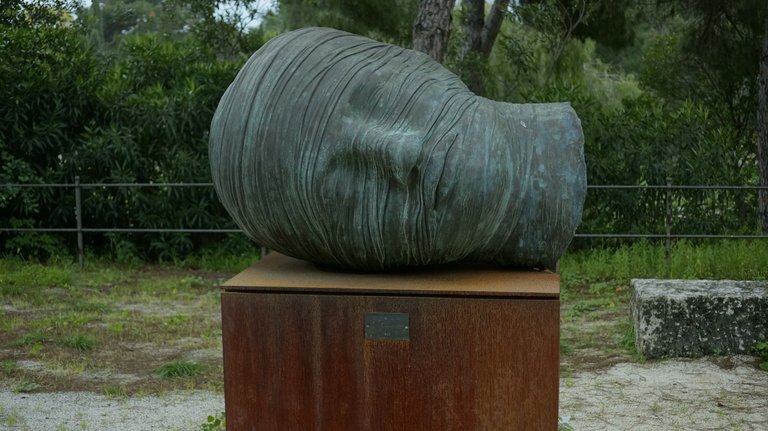
P.S.
Trwa właśnie wystawa Mitoraja w Muzeum ASP w Krakowie.
P.S.
There is currently a Mitoraj exhibition at the Academy of Fine Arts Museum in Kraków.
